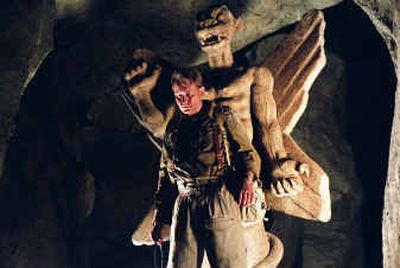Out of darkness

If it were possible for a movie to go through a long dark night of the soul, “Exorcist: The Beginning” would still be suffering.
The latest film in the demonic-possession series, which opens in theaters Friday, has had four directors and three credited screenwriters and was made not once but twice.
That last, historic event occurred because Morgan Creek Productions, which financed the project, fired director Paul Schrader after he completed his version and hired Renny Harlin to start again with a new script and a mostly new cast.
In both versions, Stellan Skarsgard plays Father Merrin, who battles a demon in 1947 Africa.
“It’s obviously a tough situation, This is a prequel to the most famous horror film of all time, as well as a remake of a movie that was made but wasn’t released,” Harlin says.
“The challenge was always to come up with something new and surprising to an audience that probably wasn’t even born when the original was made. And let’s face it: There’s nothing we can do that is more shocking than what the first movie did 30 years ago.”
In fact, it was the nearly $40 million made by 2000’s reissue of “The Exorcist” that put this fourth entry on the fast track. (The 1973 Oscar-winning smash had been followed by two bombs, 1977’s “Exorcist II: The Heretic” and 1990’s “The Exorcist III.”)
The prequel was conceived when best-selling novelist Caleb Carr (“The Alienist”) found a script by William Wisher called “Exorcist: Dominion” at the Morgan Creek offices in the late 1990s. Carr was eager to rewrite it, fleshing out the story of the young Father Lankester Merrin (played by Max Von Sydow in the ‘73 original) and his encounter with a possessed boy in a Kenyan village during the years after World War II.
“It was not a special-effects fest. My script was about the terrible things that people can do to each other,” says Carr. “There was nothing magical in it, even during a final confrontation in which the devil beats up Merrin.”
Carr’s script attracted actor Liam Neeson, who wanted to play Merrin, and veteran director John Frankenheimer. The film was ramping up when Frankenheimer left because of ill health. He died of a stroke in summer 2002, and Neeson left the project shortly after.
“When John died, I was resigned to the movie going south. I just didn’t think it would go south in such an incredibly complicated way,” says Carr. “If the producers had said right away that they just wanted to do a Saturday-matinee creature feature, that would’ve been a lot simpler.”
Instead, Schrader (“Cat People”) was brought on board even though he had a decidedly different vision.
Raised a strict Calvinist, Schrader has often dealt with the struggle between his characters’ inner demons and their struggle for a higher sense of purpose. He wrote the screenplays for Martin Scorsese’s “Taxi Driver,” “Raging Bull” and “The Last Temptation of Christ”; his director credits include “American Gigolo,” “Affliction” and “Auto Focus.”
“I actually thought I was a pretty good choice,” Schrader says. “The script was a variation on my themes: Father Merrin loses his faith, encounters the devil, and gets his faith back in the face of its extreme opposite. I didn’t want to try and (make) a horror film.”
Schrader finished shooting in February 2003. When he turned in a cut to executives at Morgan Creek, they deemed it devoid of thrills. After talking to Carr about possible rewrites, the producers decided to fire Schrader and remake the $35 million film from scratch rather than do reshoots.
With Schrader gone, Harlin (“Die Hard 2,” “Cliffhanger”) was chosen to deliver something more traditionally “Exorcist”-like. He says he had some hesitation about taking the job.
“When Morgan Creek wanted flashy stuff and spark and excitement, I said, ‘I’m not going to do that to another director’s movie. I’d rather remake it from scratch,’ ” he says.
“I was sure they’d never talk to me again, but a week or two later, they said, ‘We think your idea is exactly what we should do.’ And I thought, ‘Oh my God, what have I got myself into?’ But if I’d been offered the opportunity to make it to begin with, I would have said yes.
“So we started over. And as usually happens, people in Hollywood started rumors. But I’m very respectful of what Schrader did. He had his vision, and the producers wanted something different.
“My approach to the film was to keep (the horror) real,” Harlin adds. “We can create anything you can imagine, but there’s nothing scarier than a demonic power taking over your mind and body so you can’t control your own actions.”
Schrader’s film may yet be released on a DVD along with Harlin’s version. Schrader says he’s happy with the film he made but assumed it would be buried forever.
“I’m looking forward to having it seen in some fashion,” he says. But it isn’t easy to cast out the film’s demons.
“I always knew that there would be some blood on the floor in the editing process,” Schrader says. “I just didn’t think it would all be mine.”